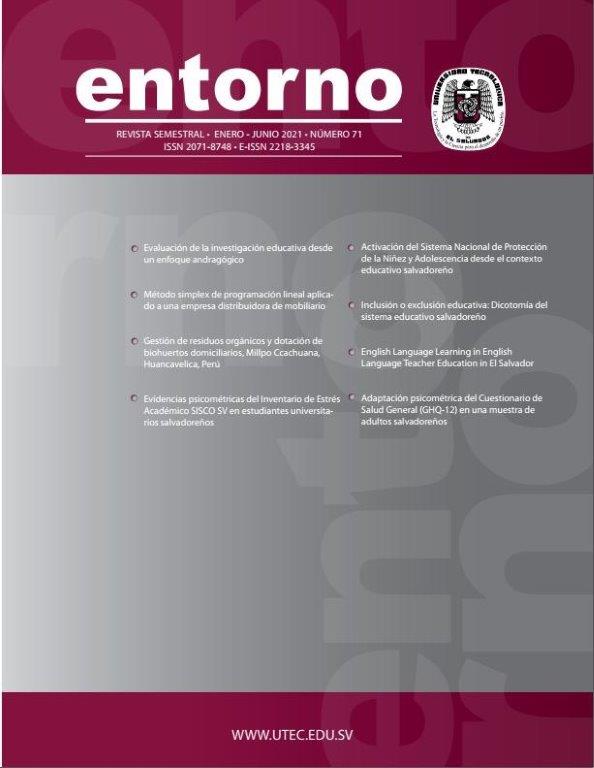English language learning in english language teacher education in El Salvador
Published 2021-01-19
Keywords
- English – Teaching - El Salvador,
- Assessment,
- Case Studies,
- Professional teacher education,
- In-service teacher training
- Linguistics ...More
Copyright (c) 2021 Entorno

This work is licensed under a Creative Commons Attribution-NonCommercial-ShareAlike 4.0 International License.
How to Cite
Abstract
This research study aimed at describing student teachers’ success stories related to the development of English language proficiency in teacher education programs at Salvadoran universities. The research methodology was qualitative and followed a phenomenological approach to understand participants’ lived experiences in learning English in El Salvador. Participants of the study were 62 professors, 57 current student teachers, 16 EFL program coordinators, and 5 alumni who attended to the two-day symposium of applied linguistics held on September 2016. The instrument used was a semi-structured interview with open and close ended questions. The data was analyzed through the use of the qualitative software NVivo 10. The findings revealed that a) teacher education should be emphasized mainly on listening, speaking, and vocabulary, b) the courses that help student teachers to enhance English proficiency are speaking, reading, and grammar, c) student teachers’ proficiency is evaluated mainly through the administration of the international TOEFL-ITP test, oral interviews, and paper and pencil tests, d) the main strategies student teachers employ to be successful on proficiency achievement tests are practice and self-paced learning, e) the strategies universities implement to enhance proficiency in teacher education programs are practice, remedial courses, professional development opportunities, and giving materials for self-study, and f) the activities student teachers frequently do outside the classroom to develop proficiency in English are watching movies, listening to music, and self-practicing
Keywords: English – Teaching – Assessment – Case studies, University professors – Assessment – Case studies, Teacher In-service teacher training, Professional teacher education – In-service teacher training, Linguistics.
DOI: https://doi.org/10.5377/entorno.v1i71.14325
URI : http://hdl.handle.net/11298/1208
References
- American Council on the Teaching of Foreign Language Guidelines. (2012). ACTFL proficiency guidelines 2012. https://www.actfl.org/sites/default/files/guidelines/ACTFLProficiencyGuidelines2012.pdf
- Dörnyei, Z. (2007). Research methods in applied linguistics: Quantitative, qualitative and mixed methologies. Oxford University Press.
- Creswell, J. (2007). Qualitative inquiry and research design: Choosing among five approaches. Sage
- Jacobs, R. (1995). English syntax: A grammar for english language professionals. Oxford University Press.
- Kamhi-Stein, L. (2004). Learning and teaching from experience: Perspectives on non-native english speaking professionals. University of Michigan Press.
- Lichtman, M. (2010). Qualitative research in education: A user’s guide (2nd ed.). SAGE Publications.
- Ministerio de Educación, Ciencia y Tecnología. (2016a). Reglamento especial para el funcionamiento de carreras y cursos que habilitan para el ejercicio de la docencia en El Salvador. https://www.jurisprudencia.gob.sv/DocumentosBoveda/D/2/2010-2019/2013/01/9D0E3.PDF
- Ministerio de Educación, Ciencia y Tecnología. (2016b). Resultados de la información estadística de instituciones de educación superior. https://www.mined.gob.sv/index.php/2015-05-12-15-29-13
- Nunan, D. (2003). Practical english language teaching: Young learners. McGraw-Hill.
- Organisation for Economic Co-operation and Development. (2009). Creating effective teaching and learning environments: First results from TALIS. OECD, Teaching and Learning International Survey.
- Patton, M. (2002). Qualitative research and evaluation methods (3rd ed.). Sage Publications.
- Raja, N. (September, 2012). The effectiveness of group work and pair work for students of english at undergraduate level in public and private sector colleges. International Journal of Scientific Research, 2(10), 1-9. doi: 10.15373/22778179/oct2013/11
- Walqui, A. (2000). Contextual factors in second language acquisition. https://eric.ed.gov/?id=ED444381
- Wellington, J. (2000). Educational research: Contemporary issues and practical approaches. Continuum.
- Wiersma, W. (1995). Research methods in education: An introduction (6th ed.). Allyn and Bacon.
